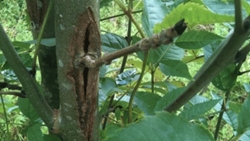
A survey of Landscape Institute members about the problem of ash dieback found a hunger for knowledge and a determination to be vigilant – but warned against panic. The survey, which had a response rate of around 5 per cent, with 310 of the membership of 6,132 responding, addressed members’ experience of Chalara fraxinea, the ash dieback disease, and asked them how well they felt it was being handled, and what should be done next.
This feedback will be used in developing the Landscape Institute’s long-term bio-security strategy, and it would like to hear from members interested in becoming more actively involved in this project .
What should we do?
In response to the question, what are the three most important things that landscape architects should do in the face of the crisis, the most common answers were:
- Landscape architects should keep themselves informed by consulting Forestry Commission and LI websites
- Stop specifying ash for the time being – though a number of members were keen to be able to plant resistant ash species to mitigate the impact on the landscape
- The importance of a diverse planting mix, and of planting UK-grown stock
- Monitor existing plantings and report any suspected disease
- Learn how to identify the disease
- Contact clients to advise on alternatives and reassure them.
Few members so far have direct experience of ash dieback. Fewer than 2 per cent had seen the disease in planting (just over a third had specified or planted ash in the past five years) and another 1.65 per cent had seen evidence of the disease elsewhere in the landscape.
Landscape impact
There was a wide range of views on what the impact on the landscape would be, with some predicting devastation and others hoping that resistant trees would emerge. One respondent wrote: ‘The management of dead/declining mature ash trees is likely to be a significant landscape management (and safety) issue over the next decade or more. For England’s strategic road network, ash has been planted to screen adjacent properties from views of the road, and to help the network integrate into the landscape. The loss of ash will open-up the roadside landscape, and long-term consideration will need to be given to replacement planting to mitigate landscape impact. I’d imagine this effect will apply across the wider landscape. There will also be a not inconsiderable ecological impact.’
Asked about the lessons that could be learned from earlier diseases, such as Dutch elm disease, key messages from members were about specifying UK-grown stock and implementing tighter import controls. Other messages include acting quickly and decisively, heeding early warnings, the danger of monoculture, that some species are resistant so not all need to be felled, monitoring for new disease and developing an early-warning system.
What next for government?
The government’s top responses should be, respondents thought:
- Improving bio-security, including import controls;
- Developing resistance to the disease in native UK ash population;
- Researching other species at risk.
Role of the institute
There was praise for the lead that the LI has taken in providing information. Asked what the organisation should do now, the meain messages were:
- Providing information and practical advice to members
- Lobbying government for an effective response now and long-term bio-security
- Supporting research
- Championing the use of native-grown stock
- Formulating new policies and guidance for landscape architects in the light of ash dieback
- Providing training on disease identification and management,
Source: Landscape Institute – Don’t Panic about Ash Dieback but Keep Informed






